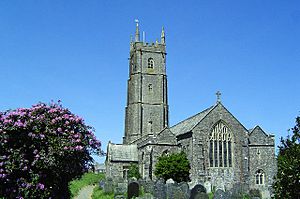Nectan of Hartland facts for kids
Quick facts for kids Saint Nectan |
|
|---|---|
The Holy Martyr Nectan
|
|
| Born | c. 468 AD Wales |
| Died | c. 510 AD Newton, Hartland, Devon |
| Venerated in | Catholic Church, Anglican Communion, Eastern Orthodox Church |
| Feast | 17 June |
| Patronage | Hartland, Devon |
Saint Nectan, sometimes called Saint Nectan of Hartland, was a holy man who lived in the 5th century. He lived in a place called Stoke, which is in Hartland, England. A very important church there, St Nectan's Church, Hartland, is named after him.
Contents
Saint Nectan's Life Story
We know about Saint Nectan from an old book written in the 14th century. This book tells us about his life, how his body was found, and many amazing stories of miracles he performed. This story of his life, called a hagiography, was probably written around the end of the 12th century.
The story says that Nectan was born in Ireland around 423 AD. He was the oldest of 24 children of King Brychan of Brycheiniog (which is now Brecknock in Wales). Nectan heard about a famous hermit, Saint Anthony, who lived in the Egyptian desert. Nectan was inspired to live a similar simple life.
To find more quiet places, Nectan and his friends left Wales. They planned to settle wherever their boat landed. Nectan and his companions ended up on the northern coast of Devon at Hartland. They lived there for several years in a thick forest. Nectan's family would visit him there on the last day of each year. Later, he moved to a quiet valley where there was a spring.
A Story of Kindness and Sacrifice
In Hartland, Nectan lived alone in a peaceful valley. One day, he helped a swineherd (someone who looks after pigs) find his lost pigs. As a thank you, the swineherd gave Nectan two cows.
Sadly, Nectan's cows were later stolen. When he found them, he tried to teach the robbers about the Christian faith. Instead of listening, the robbers attacked him and cut off his head. The story says that Nectan then picked up his own head and walked back to his well before he finally fell down and died. When the man who killed Saint Nectan saw this, he became very confused and upset. The other thief buried Nectan. After that, amazing miracles began to happen at Saint Nectan's tomb. People also say that wherever Nectan's blood fell, beautiful foxglove flowers grew.
Nectan in Cornwall
Saint Nectan is also connected to St Nectan's Glen and Waterfall near Tintagel in Cornwall. It is believed he spent some time there as a hermit (someone who lives alone for religious reasons). Nectan is thought to have built his hermitage (his quiet home) above the waterfall. According to legend, he would ring a silver bell during stormy weather. This bell would warn ships about the dangerous rocks near the Rocky Valley.
A King's Victory
Nectan is also said to have appeared in 937 AD, just before a big battle called the Battle of Brunanburh. A young man from Hartland was very sick with a serious illness. He prayed to God and Saint Nectan for help. Saint Nectan appeared to the young man just after midnight and touched the sick part of his body, healing him completely.
When King Athelstan heard about this miracle, he asked for more information about Saint Nectan. The young man told the king to have faith in Saint Nectan, and he would win the battle. After the battle, which King Athelstan won, he visited Hartland. He gave land and gifts to the church dedicated to Saint Nectan.
How Saint Nectan Was Honored

After Nectan died, many people began to honor him. His shrine (a special place where he was remembered) became very popular throughout the Middle Ages. Both Saxon kings and Norman lords supported his shrine.
Lyfing, who was the Bishop of Crediton, approved the moving of Nectan's body to a new place. He provided bells, lead for the church roof, and a special decorated box for Nectan's remains. Also, Nectan's staff (a walking stick) was decorated with gold, silver, and jewels. Land was given to the church to help protect it from pirates.
The church and shrine were later rebuilt and cared for by the Augustinian canons from the nearby Hartland Abbey. This continued from the 12th century until these religious groups were stopped during the Reformation.
Several other churches in Devon are also dedicated to Saint Nectan. Two very old ones are in Welcombe, just south of Hartland, and probably Ashton (which is now called St John the Baptist). There is also an old chapel dedicated to Saint Nectan near St Winnow in Cornwall, and another church in the village of Ashcombe in Devon.
Feast Day and Traditions
Nectan's feast day is on 17 June. This is believed to be the day he died, around 510 AD. This day was celebrated in places like Launceston, Exeter, and Wells. Even today, there is a tradition of taking foxgloves to his well on that day. Other dates when he is remembered include 18 May, 14 February, and 4 December (which is the day his body was moved).
Patronage
Saint Nectan is the patron saint of Hartland, Devon. This means he is considered a special protector of that area.
See also

